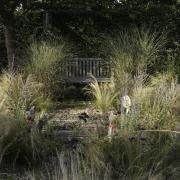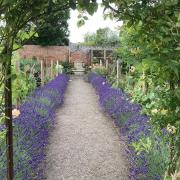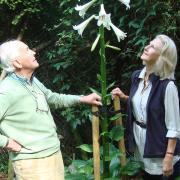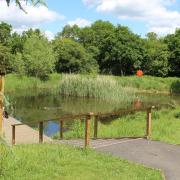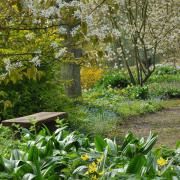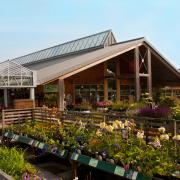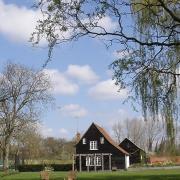Working with the soil conditions found over much of Essex can yield some rewarding results. Tim Carter, a horticulturalist at Noak Hill near Romford, has used his experience to widen the range of plants available for the county’s gardens | Words: Debbie Thomson

Essex gardeners, used to the heavy clay soils typical of the county, will be interested to learn about a local grower who has made a career out of understanding plants that don’t just survive, but thrive on the heavy and wet, or alternatively hard-baked, clay conditions in which many of us garden.
Tim Carter, has his home, garden and business all on one site at Long House Plants at Noak Hill, a delightfully rural setting, ten minutes from both Romford and Brentwood, and just inside the M25.
Collector, propagator, designer, nurseryman, gardener, landscaper, lecturer and artist: the list of Tim’s skills is impressive and in partnership with his wife Jean who, in addition, takes responsibility for photographing the collection, a successful business has materialised. Key to this success is the level of effort and attention to detail which goes into it.
While visitors can enjoy the garden at Long House Plants as a creative work in itself, they would be missing the hard work demanded of the garden and the part it plays in propelling the business.

Tim constantly seeks out plants that can flourish in the soil conditions – conditions that can vary within the garden itself – as well as experimenting with plant combinations and the way the light affects them.
Light, whether it be from the sun in midsummer or midwinter, makes a big difference. Similarly, a border will look very different early in the morning, seeming to change colour just a few hours later as the sun moves around the garden.
Having worked in this space for over 15 years, Tim has identified key moments in the year when, subject to the weather, certain plants of the garden will radiate light and colour, such as a group of cornus when viewed from the back of the house for just a few days each February.
Simultaneously, Long House Plants is acting as a trial garden where new plants are tested for their garden worthiness. Tim will experiment with different species and cultivars to identify those that withstand particular conditions better than others, typically the soil structure.

Importantly, the garden also acts as a source of seeds and propagation material that supplies the on-site production area and eventually the plant nursery.
Knowing that the plants for sale in his nursery have made it through these various tests is enough to keep Tim’s troupe of loyal customers coming back for more, eager to try out cultivars not available in garden centres and to be rewarded with new and interesting hardy, outdoor plants.
‘We’ve had the business here since 2006,’ says Tim. ‘The culmination of past experiences such as plant hunting in Australia, Tasmania and New Zealand, studying commercial horticulture, being a landscaper, teacher and exhibitor have found their natural conclusion at Noak Hill.
‘I have the luxury of land on which to run my trials and expand the number of plants I am able to offer, plus space to sell a good range of them’.

Take for example the agapanthus, plants generally associated with August flowering. Through his trialling, Tim has been able to introduce varieties to his plant nursery which start flowering as early as June with ‘Dwarf White’, to ‘Gayle’s Lilac’ and ‘Jodie’ still flowering into November.
Varieties such as ‘Buckingham Palace’ look magnificent during August in well-drained borders. Additionally, he can advise which will do well in pots, which are good for cutting and even suggest some dwarf evergreen varieties such as ‘Streamline’.
Interest in the garden really gets going in June when geraniums, salvias, grasses, iris and day lilies start to flower. This is when the garden would ordinarily start opening to the public. From then on it just gets better and better through to November, but with early autumn being particularly beautiful.
In recent years the dry areas have been of interest with their ability to withstand the long hot summers with little or no irrigation. Here salvia, geranium, cytisus and eryngium flourish, while just around the corner an area with heavy wet soil makes a comfortable home for lythrum, hemerocallis, iris, lysimachia, ligularia and giant moisture-loving gunnera.

‘Plants should engage all the senses,’ says Tim. ‘I explore combinations of colours and shapes while never forgetting to make plants with glorious scents easy to access and appreciate. I love the graceful movement and the wonderful sound made by grasses as they are blown by the wind and the texture and feel of foliage too.
‘Birdsong adds another dimension to the experience as do the far-reaching views across the countryside. Horticulture is the art and science of gardening and I am lucky to be as interested in the aesthetic side as well as the technical.’
Tim’s other motivation is always to help people however he can. This might be by giving talks in aid of the local Salvation Army or hosting coffee mornings for Macmillan Cancer Support.
Mindful of the necessity of making the garden accessible to all, hard landscaping is suitable for wheelchair users as are areas to shelter from the rain. Staff are happy to share their knowledge with visitors and the clear label on each plant is a joy for those of us who like to explore a garden with a camera at the ready.

This approach continues in the sales area. Tim has an A to Z in part of the nursery as well as sections for shade, roses, climbers and various collections. He also uses the sales benches to display plants together and builds mini gardens or beds to inspire customers.
‘I love sharing what I have learned. That is what made the shutdown due to Coronavirus so hard to bear, but at least I am now able to open the nursery again with relevant restrictions in place.
Five lots of customers are allowed in the nursery at a time and we ask that you shop with the maximum of one other person and keep 2m apart. The open days I organise as part of the National Garden Scheme are not happening, at least not for the moment.
‘All I can say is that when the public are allowed back in they will see I haven’t been slacking. I am working on a new rose garden on a completely uncultivated piece of land near to the house and the winter garden will be filling out nicely.’
Tim would normally open for the National Garden Scheme during the months of June, July, August and September and he would also offer tours of the garden to private groups.
When visiting the garden, visitors should look out for the spots that are marked along some of the paths.
These are vantage points from which to see the borders at their best, where the view is like a painting, a sweet spot if you like, that reveals Tim’s experienced eye for design at its very best.
Find out more
Long House Plants
Church Road, Noak Hill, Romford RM4 1LD
01708 371719
At the time of writing, the nursery has just reopened following lockdown and is open three days a week (Friday and Saturday, 10am to 5pm, and Sunday 10am to 4pm) plus Bank Holidays, 10am to 5pm.








